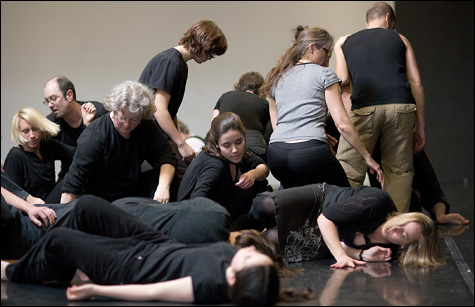
TOM’S WEALTH: Mr. Sawyer’s assets got translated into movement by everyday people. |
The assets of Tom Sawyer, as quoted by Caitlin Corbett from Mark Twain, consist of worthless objects you could pick up and stick in your pocket, broken treasures you can’t throw away, and a motherless animal or two. Tom’s Wealth: A Dance for the Masses, which premiered last weekend at the Tsai Center, is about the physical equivalent of these toys and talismans.
Corbett has been working for a year or so with some 30 “non-dancers” of all ages and types. From the way she deployed them among the members of her own company, Leah Bergmann, Erin Koh, Rebecca Lay, Kaela Lee, and Marjorie Morgan, I gather she takes the word “masses” in a sociological sense: dance for the common man, not dance for crusading crowds at a rally. She’s attracted to simple movements and the beauty of ordinary souls.
For this variegated group Corbett seems to have chiseled down a movement style I remember as being quite complex into some brief, basic, and low-intensity combinations of arm gestures, skips and runs, turns and falls. The five company dancers make the lexicon more elaborate, and subgroups of the masses develop it through repetition or doubling.
One phrase ends with a fall onto the back, arms and flexed legs hanging in the air above the body. You get to see this robotic shape many times during the piece. When the dancers turn on their sides, the same pose looks entirely different, more three-dimensional. And when several people fall into it at once, the stage seems to acquire a set of horizontal levels.
Corbett’s choreographic structures are more interesting than the simple body movements that convey them. In frequent counterpoint patterns, a large group of people move in unison or stand in place while a few individuals weave through them. The five company members do a long sequence of arm semaphores, back falls, and vigorous arm swings that carry the whole body out into a leg extension or a side jump. Five more dancers arrive and do their version of the phrase in canon with the first group.
In one sequence, a dancer has a shadow behind her doing the same movements. At some point the shadow steps in front, but instead of getting to be the leader, she falls and her partner steps over her. The shadow dance resumes as before.
Tom’s Wealth is anchored to the text in photographs by Akos Szilvasi and video by Ann Steuernagel. Interspersed with shots of the dancers rehearsing, a skeleton key and bits of blue glass and orange peelings get projected on the backdrop, enlarged to heroic proportions. One micro-edited loop shows dozens, maybe hundreds of feet swimming past the camera. As these images recur, they provoke a thoughtful stillness. The dancers stop whatever they’re doing to let the pictures speak.
Chris Eastburn’s offbeat arrangements of folk songs and nursery tunes accompany the dancing. The precise musical timing with which Corbett set the movement gave more of a dancelike character to the gestural moves, and keeping to the musical scheme must have been a big part of the challenge for the non-dancers.